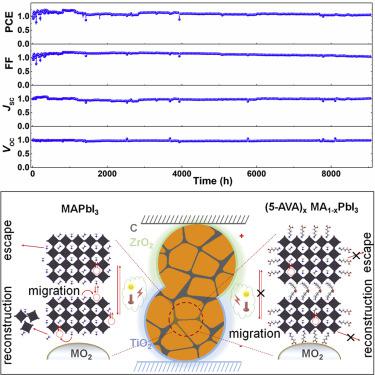Joule ( IF 38.6 ) Pub Date : 2020-10-16 , DOI: 10.1016/j.joule.2020.09.010 Anyi Mei , Yusong Sheng , Yue Ming , Yue Hu , Yaoguang Rong , Weihua Zhang , Shulin Luo , Guangren Na , Chengbo Tian , Xiaomeng Hou , Yuli Xiong , Zhihui Zhang , Shuang Liu , Satoshi Uchida , Tae-Woong Kim , Yongbo Yuan , Lijun Zhang , Yinhua Zhou , Hongwei Han

|
The stability of perovskite solar cells (PSCs) has been considered as the largest obstacle to their commercialization. Herein, we observed that the main failure mechanism for MAPbI3 perovskite is the escape of methylammonium (MA) iodide at the grain boundaries in an open space or the reconstruction of crystal in a confined small space, as well as the irreversible long-distance ionic migration under the multiple actions of light, heat, and electrical bias. Strengthened with bifunctional organic molecular of 5-ammoniumvaleric acid (5-AVA) iodide at the grain boundaries, the MAPbI3 crystal was localized in the nanoscale, and thus, the decomposition or reconstruction was inhibited and the ionic migration became reversible. As a result, we propose a reliable approach to make PSCs meet stability standards of IEC61215:2016 qualification tests. A printable PSC filled with (5-AVA)XMA1-XPbI3 has been working for more than 9,000 h at a maximum power point of 55°C ± 5°C without obvious decay.
中文翻译:

通过9,000-h以上的运行跟踪将钙钛矿太阳能电池稳定到IEC61215:2016标准
钙钛矿太阳能电池(PSC)的稳定性已被认为是其商业化的最大障碍。在这里,我们观察到MAPbI 3钙钛矿的主要失效机理是甲基碘(MA)碘化物在开放空间的晶界逸出或在狭窄的小空间中晶体的重建,以及不可逆的长距离离子在光,热和电偏压的多种作用下迁移。MAPbI 3在晶界处由双功能的5-铵戊酸(5-AVA)碘化物有机分子强化晶体位于纳米级,因此,分解或重建受到抑制,离子迁移变得可逆。因此,我们提出了一种可靠的方法来使PSC满足IEC61215:2016资格测试的稳定性标准。填充有(5-AVA)X MA 1-X PbI 3的可打印PSC在55°C±5°C的最大功率点下工作9,000小时以上,而没有明显的衰减。











































 京公网安备 11010802027423号
京公网安备 11010802027423号